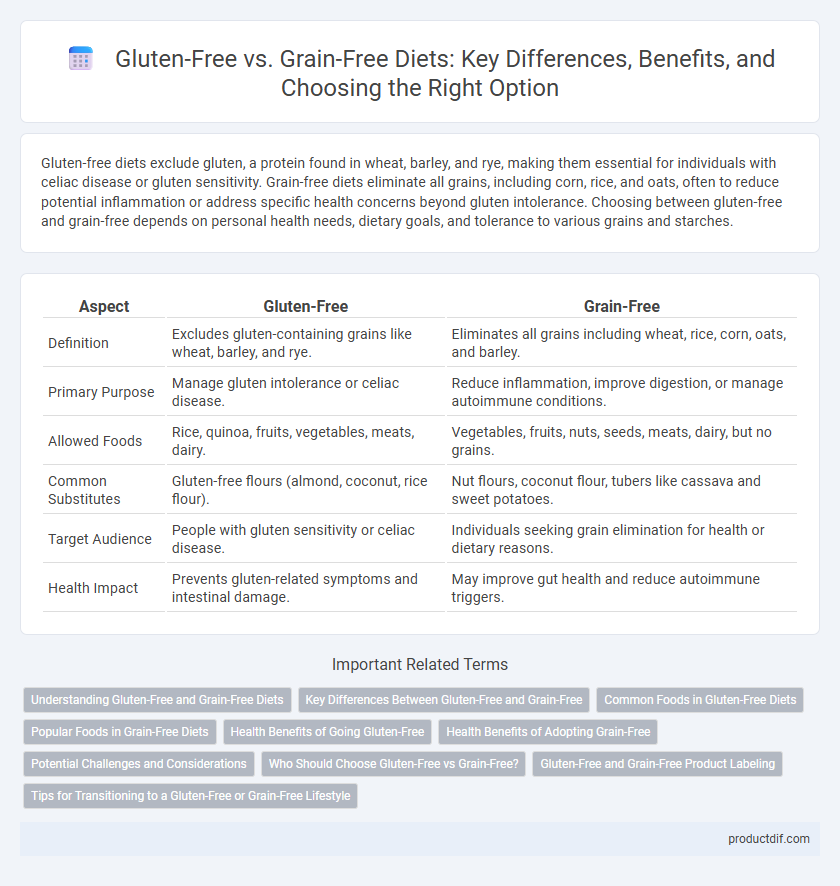Gluten-free diets exclude gluten, a protein found in wheat, barley, and rye, making them essential for individuals with celiac disease or gluten sensitivity. Grain-free diets eliminate all grains, including corn, rice, and oats, often to reduce potential inflammation or address specific health concerns beyond gluten intolerance. Choosing between gluten-free and grain-free depends on personal health needs, dietary goals, and tolerance to various grains and starches.
Table of Comparison
| Aspect | Gluten-Free | Grain-Free |
|---|---|---|
| Definition | Excludes gluten-containing grains like wheat, barley, and rye. | Eliminates all grains including wheat, rice, corn, oats, and barley. |
| Primary Purpose | Manage gluten intolerance or celiac disease. | Reduce inflammation, improve digestion, or manage autoimmune conditions. |
| Allowed Foods | Rice, quinoa, fruits, vegetables, meats, dairy. | Vegetables, fruits, nuts, seeds, meats, dairy, but no grains. |
| Common Substitutes | Gluten-free flours (almond, coconut, rice flour). | Nut flours, coconut flour, tubers like cassava and sweet potatoes. |
| Target Audience | People with gluten sensitivity or celiac disease. | Individuals seeking grain elimination for health or dietary reasons. |
| Health Impact | Prevents gluten-related symptoms and intestinal damage. | May improve gut health and reduce autoimmune triggers. |
Understanding Gluten-Free and Grain-Free Diets
Gluten-free diets eliminate gluten, a protein found in wheat, barley, and rye, to help individuals with celiac disease or gluten sensitivity avoid digestive issues and inflammation. Grain-free diets exclude all grains, including gluten-free options like rice and corn, aiming to reduce carbohydrate intake or address autoimmune conditions. Understanding these distinctions is essential for making informed dietary choices that meet specific health needs and lifestyle goals.
Key Differences Between Gluten-Free and Grain-Free
Gluten-free diets strictly eliminate gluten, a protein found in wheat, barley, and rye, making them essential for managing celiac disease and gluten intolerance. Grain-free diets exclude all grains, including gluten-containing and non-gluten grains like rice, corn, and oats, often adopted to reduce inflammation or for paleo lifestyle reasons. Understanding these distinctions is crucial for selecting appropriate dietary plans tailored to specific health needs or allergies.
Common Foods in Gluten-Free Diets
Common foods in gluten-free diets include naturally gluten-free grains such as rice, quinoa, and corn, which provide essential nutrients and fiber. Many gluten-free products also incorporate alternative flours like almond flour, coconut flour, and tapioca starch to maintain texture and flavor. Fruits, vegetables, meat, dairy, and legumes are staples in gluten-free diets, ensuring balanced nutrition without gluten-containing grains.
Popular Foods in Grain-Free Diets
Popular foods in grain-free diets often include vegetables, nuts, seeds, fruits, and lean proteins like chicken and fish. Root vegetables such as sweet potatoes and carrots replace grains as primary carbohydrate sources. Nut flours like almond and coconut flour are commonly used in baking to maintain a grain-free approach while providing essential nutrients.
Health Benefits of Going Gluten-Free
Choosing a gluten-free diet can significantly improve digestive health, reduce inflammation, and alleviate symptoms associated with celiac disease and gluten sensitivity. Eliminating gluten helps enhance nutrient absorption and supports gut healing, promoting overall well-being. Many individuals experience increased energy levels and reduced bloating when adopting a gluten-free lifestyle.
Health Benefits of Adopting Grain-Free
Adopting a grain-free diet can significantly improve digestive health by reducing inflammation and alleviating symptoms related to gluten sensitivity and grain allergies. This dietary approach also supports better blood sugar regulation and can promote weight loss by eliminating high-glycemic grains. Enhanced energy levels and reduced risks of chronic conditions such as autoimmune disorders are notable health benefits associated with grain-free eating.
Potential Challenges and Considerations
Gluten-free diets eliminate wheat, barley, and rye, which can lead to challenges in obtaining sufficient fiber, vitamins, and minerals often fortified in gluten-containing products. Grain-free diets exclude all grains, including rice and corn, potentially resulting in limited carbohydrate sources and nutrient imbalances if not carefully planned. Both diets require attention to alternatives such as legumes, nuts, seeds, and vegetables to maintain balanced nutrition and avoid deficiencies.
Who Should Choose Gluten-Free vs Grain-Free?
Individuals with celiac disease or gluten sensitivity should choose gluten-free diets to avoid wheat, barley, and rye proteins that trigger adverse reactions. Those with grain allergies, autoimmune conditions like Hashimoto's thyroiditis, or digestive issues may benefit more from grain-free diets, which exclude all cereal grains including gluten-free options like rice and corn. Athletes or health enthusiasts might select grain-free plans to reduce inflammation and improve gut health, while gluten-free is primarily essential for managing gluten-related disorders.
Gluten-Free and Grain-Free Product Labeling
Gluten-free and grain-free product labeling helps consumers identify foods free from gluten proteins or all grains, respectively, addressing specific dietary restrictions and intolerances. Gluten-free labels comply with FDA standards limiting gluten content to less than 20 parts per million, ensuring safety for people with celiac disease or gluten sensitivity. Grain-free labels indicate the absence of grains such as wheat, barley, rye, oats, and corn, catering to those following ketogenic, paleo, or grain-elimination diets.
Tips for Transitioning to a Gluten-Free or Grain-Free Lifestyle
Transitioning to a gluten-free or grain-free lifestyle requires careful label reading to avoid hidden sources of gluten or grains in processed foods. Prioritize naturally gluten-free or grain-free whole foods such as vegetables, fruits, lean proteins, nuts, and seeds to ensure balanced nutrition. Gradually introduce alternatives like almond flour, coconut flour, or quinoa while monitoring digestive responses to maintain a comfortable adjustment period.
Gluten-Free vs Grain-Free Infographic

 productdif.com
productdif.com